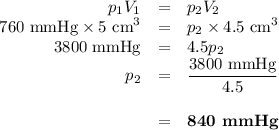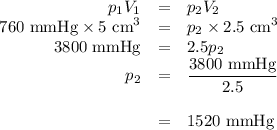Se tienen 5 cm3 de aire encerrado en una jeringa, siendo p = 760
mmHg. Para reducir el volumen...

Physics, 23.05.2020 21:58, hehelupesss5245
Se tienen 5 cm3 de aire encerrado en una jeringa, siendo p = 760
mmHg. Para reducir el volumen que ocupa el gas se ejerce presión,
manteniendo constante la temperatura:
a- Calcula qué presión habrá que ejercer sobre el émbolo de la
jeringa para que el volumen sea una décima parte menor que el inicial.
b- ¿En cuánto debe aumentar la presión para que el volumen se
reduzca a la mitad?

Answers: 2
Other questions on the subject: Physics

Physics, 21.06.2019 20:20, Perdikaris
Aforce of 34n stretches a very light ideal spring 0.73 m from equilibrium, what is the force constant (spring constant) of the spring? (a) 47n/m (b) 38n/m (c) 53n/m (d) 25n/m
Answers: 3

Physics, 22.06.2019 12:20, ginachuquiano450
Aball with a mass of 275 g is dropped from rest, hits the floor and rebounds upward. if the ball hits the floor with a speed of 2.40 m/s and rebounds with a speed of 1.70 m/s, determine the following. (a) magnitude of the change in the ball's momentum (let up be in the positive direction.)
Answers: 1

Physics, 22.06.2019 14:30, samehajamal1234567
When the displacement of a mass on a spring is 12a the half of the amplitude, what fraction of the mechanical energy is kinetic energy? at what displacement, as a fraction of a, is the mechanical energy half kinetic and half potential?
Answers: 3

Physics, 22.06.2019 15:30, anahitrejo1
1kg of water needs to recieve 4200j of energy to go from 90 degrees to 91 degrees. what is the specific heat capacity of water? what are the units?
Answers: 1
Do you know the correct answer?
Questions in other subjects:




Health, 04.02.2020 07:47

Biology, 04.02.2020 07:47


Mathematics, 04.02.2020 07:47

Mathematics, 04.02.2020 07:47


Chemistry, 04.02.2020 07:47









